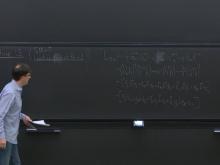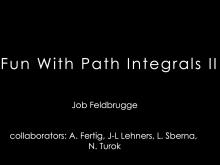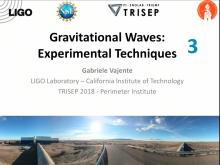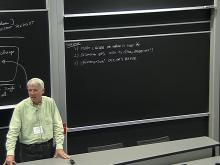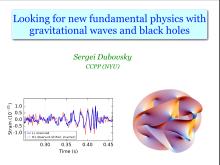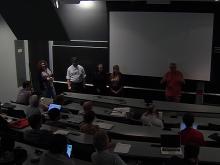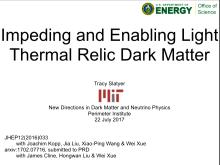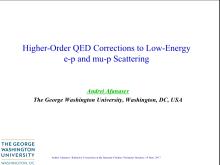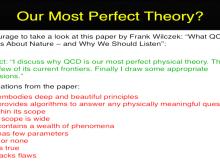Particle physics is the science which identifies nature's constituents and interactions at the most fundamental level, with an emphasis on comparing theoretical ideas with both terrestrial experiments and astrophysical observations. This mandate gives it a strong overlap with string theory, quantum gravity and cosmology. Particle physicists at Perimeter Institute are currently involved in identifying how cosmological observations and terrestrial accelerator and underground experiments constrain the theoretical possibilities for physics beyond the Standard Model.
Format results
-
12 talks-Collection NumberC20005
Talk
-

PSI 2019/2020 - Standard Model and Beyond - Part 1 - Lecture 1
Latham Boyle University of Edinburgh
-

PSI 2019/2020 - Standard Model and Beyond - Part 1 - Lecture 2
Latham Boyle University of Edinburgh
-

PSI 2019/2020 - Standard Model and Beyond - Part 1 - Lecture 3
Latham Boyle University of Edinburgh
-

PSI 2019/2020 - Standard Model and Beyond - Part 1 - Lecture 5
Latham Boyle University of Edinburgh
-

PSI 2019/2020 - Standard Model and Beyond - Part 1 - Lecture 6
Latham Boyle University of Edinburgh
-

PSI 2019/2020 - Standard Model and Beyond - Part 1 - Lecture 7
Latham Boyle University of Edinburgh
-

PSI 2019/2020 - Standard Model and Beyond - Part 1 - Lecture 8
Latham Boyle University of Edinburgh
-

PSI 2019/2020 - Standard Model and Beyond - Part 1 - Lecture 9
Latham Boyle University of Edinburgh
-
-
Simplicity III
17 talks-Collection NumberC19044Talk
-

On the possible role of nilpotent internal symmetries in unification
Andras Laszlo Wigner Research Centre for Physics
-

Rethinking the origin of neutrino masses: the role of gravity
Lena Funcke University of Bonn
-

Swampland Constraints on Neutrino Masses and Dark Energy
Irene Valenzuela European Organization for Nuclear Research (CERN)
-

-

Exceptional Quantum Algebra for the Standard Model of Particle Physics
Ivan Todorov Bulgarian Academy of Sciences
-

SO(7,7) Structure of Standard Model Fermions
Kirill Krasnov University of Nottingham
-

The Standard Model from A Jordan Algebra
Latham Boyle University of Edinburgh
-

Particle Theory from Jordan Geometry
Shane Farnsworth University of Regensburg
-
-
Cosmological Frontiers in Fundamental Physics 2019
22 talks-Collection NumberC19037Talk
-

CPT-Symmetric Universe
Latham Boyle University of Edinburgh
-

Brane cosmology and the self-tuning of the cosmological constant
Francesco Nitti Université Paris Cité
-

New Physics in the Rayleigh-Jeans tale of the CMB and cosmic 21cm signal
Maxim Pospelov University of Minnesota
-

Gravitational waves in the inhomogeneous Universe
Masamune Oguri University of Tokyo
-

-

Discussion: Where in the Cosmos should we look for novel physics?
Elias Kiritsis University of Crete
-

Gravitational wave standard sirens
Samaya Nissanke University of Amsterdam
-

Cosmology and fundamental physics with FRBs
Ue-Li Pen Canadian Institute for Theoretical Astrophysics (CITA)
-
-
Tri-Institute Summer School on Elementary Particles 2018
39 talks-Collection NumberC18015Talk
-
Asymptotic Safety in a Dark Universe
17 talks-Collection NumberC18012Talk
-

Charting Fundamental Interactions
Francesco Sannino CP3-Origins
-

Asymptotic safety with and without supersymmetry
Daniel Litim University of Sussex
-

-

Progress in constructing an Asymptotically safe Standard Model
Steven Abel Durham University
-

Cosmological non-Constant Problem
Niayesh Afshordi University of Waterloo
-

-

UV-complete relativistic field theories and softened gravity
Alberto Salvio Scuola Normale Superiore di Pisa
-

Asymptotic safety of gravity-matter systems and effective universality
Manuel Reichert University of Southern Denmark
-
-
Searching for New Particles with Black Hole Superradiance
11 talks-Collection NumberC18010Talk
-

Searching for Light Bosons with Black Hole Superradiance
Savas Dimopoulos Perimeter Institute for Theoretical Physics
-

Superradiant instabilities and rotating black holes
Sam Dolan University of Southampton
PIRSA:18050028 -

Superradiant instabilities and rotating black holes
Avery Broderick University of Waterloo
-

Measuring Stellar-Mass Black Hole Spins via X-ray Spectroscopy
James Steiner Massachusetts Institute of Technology (MIT)
-

Superradiance Beyond the Linear Regime
Frans Pretorius Princeton University
-

Characterization of compact objects with present and future ground-based gravitational-wave detectors
Salvatore Vitale Massachusetts Institute of Technology (MIT)
-

LIGO and Virgo continuous wave searches - Overview and all-sky searches
keith Riles University of Michigan–Ann Arbor
-

Directed and targeted searches for continuous gravitational waves
Sylvia Zhu Albert Einstein Institute
-
-
Experimental techniques in table-top fundamental physics
24 talks-Collection NumberC17030Talk
-

Welcome and Opening Remarks
Asimina Arvanitaki Perimeter Institute for Theoretical Physics
-

Theory Talk
Asimina Arvanitaki Perimeter Institute for Theoretical Physics
-

A three-dimensional optical lattice clock: precision at the 19th digit
Edward Marti University of Colorado Boulder
-

Measurement of the fine structure constant as a test of the standard model
Holger Mueller University of California, Berkeley
-

Superconducting accelerometer technology for precision tests of gravitation and search for new interactions
Ho Jung Paik University of Maryland, College Park
-

Searching for axions and new short-range forces with resonant sensors
Andrew Geraci University of Nevada Reno
-

Testing Gravity at Extreme Scales
Giorgio Gratta Stanford University
-

Precision Physics in Storage Rings
Yannis Semertzidis Institute for Basic Science
-
-
New Directions in Dark Matter and Neutrino Physics
28 talks-Collection NumberC17026Talk
-

-

CRESST Detectors for Dark Matter and Neutrino Physics
Federica Petricca Max Planck Institute
-

Getting the Most out of Liquid Xenon
Rafael Lang Columbia University
-

-

-

Direct detection signals of light dark matter
Josef Pradler Austrian Academy of Sciences
-

-

-
-
Radiative Corrections at the Intensity Frontier of Particle Physics
12 talks-Collection NumberC17017Talk
-

-

Precision calculations for muonic bound states
Andrzej Czarnecki University of Alberta
-

-

SCET for precision physics at high and low energies
Thomas Becher University of Bern
-

Higher-order corrections for neutrino experiments
Kevin Mcfarland University of Rochester
-

New physics searches in low-energy experiments
Andre de Gouvea Northwestern University
-

-

Simulation tools for neutrino experiments
Gabriel Perdue Fermi National Accelerator Laboratory (Fermilab)
-
-
2015 Tri-Institute Summer School on Elementary Particles
46 talks-Collection NumberC15032Talk
-

The Standard Model – Theory: Electroweak Model
Michael Peskin Stanford University
-

Astroparticle Physics – Theory: WIMP Paradigm
Miriangela Lisanti Princeton University
-

The Standard Model – Theory: Parton Model
Michael Peskin Stanford University
-

Astroparticle Physics – Theory: Dark Matter Distribution in MW
Miriangela Lisanti Princeton University
-

The Standard Model – Theory: Altarelli-Parisi evolution
Michael Peskin Stanford University
-

Astroparticle Physics – Theory: Direct detection
Miriangela Lisanti Princeton University
-

The Standard Model – Theory: Events and processes @ the LHC
Michael Peskin Stanford University
-

Astroparticle Physics – Theory: Indirect detection
Miriangela Lisanti Princeton University
-
-

-

-
PSI 2019/2020 - Standard Model and Beyond - Part 1
12 talks-Collection NumberC20005PSI 2019/2020 - Standard Model and Beyond - Part 1 -
Simplicity III
17 talks-Collection NumberC19044This cross-disciplinary workshop gathers theorists who have been working on novel approaches to understanding the structure of the Standard Model and its link to cosmology and gravity. It follows the previous Simplicity I and II workshops at Princeton University (2014) and Fermilab (2016) and will be a small informal meeting with plenty of room for discussions.
-
Cosmological Frontiers in Fundamental Physics 2019
22 talks-Collection NumberC19037The workshops focuses on novel frontiers in observational cosmology and astrophysics and how they shed light fundamental questions in understanding the universe. Registration for this workshop is now open.
-
Tri-Institute Summer School on Elementary Particles 2018
39 talks-Collection NumberC18015The 2018 Tri-Institute Summer School on Elementary Particles (TRISEP) will be held July 9-20 2018 in Perimeter Institute for Theoretical Physics Waterloo ON, Canada. TRISEP is an international summer school organized jointly by the Perimeter Institute for Theoretical Physics, SNOLAB, and TRIUMF Canada s laboratory for particle and nuclear physics. TRISEP will feature lectures by leading experts in the field of particle physics in its broadest sense and is designed to be very interactive with ample time for questions, discussions and interaction with the speakers. The school is intended for graduate students of all levels who were already exposed to quantum field theory. For further information, please visit http:///.trisep.ca
-
Asymptotic Safety in a Dark Universe
17 talks-Collection NumberC18012The asymptotic safety paradigm is currently emerging as a highly promising idea for Beyond-Standard-Model physics with key progress in asymptotically safe quantum gravity and asymptotically safe matter models. The last years have seen not only the development of asymptotically safe gravity-matter models but also the discovery of asymptotically safe beyond Standard Model matter models that are under control in perturbation theory. New exciting avenues in (astro) particle physics are now waiting to be explored. For example although the nature of dark matter is a long-standing riddle it is a fact that experimental searches have so far not provided any direct clues but have instead come up with ever more stringent constraints on theoretically preferred regions of parameter space for dark-matter-models. Thus the key to unraveling this riddle could be a new theoretical paradigm to guide model builders. This workshop aims at exploring whether asymptotic safety can be a candidate for this new paradigm. We aim to bring together experts on phenomenological models and quantum gravity to probe both the theoretical viability and empirical signatures of asymptotically safe extensions of the standard model that include gravity. To facilitate a highly productive meeting that can trigger new collaborations each talk will be followed up by 15-20 minutes discussion time. Further each day of the workshop will feature a dedicated discussion session. Participants will be encouraged to contribute questions for the discussion both before as well as during the workshop. The last day of the workshop will conclude with a roadmap discussion during which all participants will be given the opportunity to propose concrete suggestions for follow-up work that might lead into future joint projects.
-
Searching for New Particles with Black Hole Superradiance
11 talks-Collection NumberC18010Black hole superradiance is a fascinating process in general relativity and a unique window on ultralight particles beyond the standard model. Bosons -- such as axions and dark photons -- with Compton wavelengths comparable to size of astrophysical black holes grow exponentially to form large clouds spinning down the black hole in the process and produce monochromatic continuous gravitational wave radiation. In the era of gravitational wave astronomy and increasingly sensitive observations of astrophysical black holes and their properties superradiance of new light particles is a promising avenue to search for new physics in regimes inaccessible to terrestrial experiments. This workshop will bring together theorists data analysts and observers in particle physics gravitational wave astronomy strong gravity and high energy astrophysics to explore the signatures of black hole superradiance and to study the current and future possibilities of searching for new particles with black holes.
-
Experimental techniques in table-top fundamental physics
24 talks-Collection NumberC17030In the last few years there has been a resurgence of interest in small scale high sensitivity experiments that look for new forces and new particles beyond the Standard Model. They promise to expand our understanding of the Cosmos and possibly explain mysteries such as Dark matter in a way that is complementary to colliders and other large scale experiments. There is a number of different physics motivations and approaches currently being explored in many on-going and newly proposed experiments and they often share common experimental techniques.Many workshops in this field focus on the theory motivations behind these experiments without emphasis on the details of the experimental techniques that enable precision measurements. There is also substantial experimental expertise across many fields, often outside of fundamental physics community, that can be relevant to ongoing and proposed experiments.Thus, we decided to organize the workshop around some of the common experimental techniques. We hope it will be educational for both experimentalists and theorists and lead to discussions on the best way forward. We would like to bring together experimentalists with different expertise in the hope that it will lead to new ideas through interdisciplinary interactions. For theorists, we expect it to provide better appreciation of the challenges and opportunities in improving the sensitivity of precision measurement experiments.
-
New Directions in Dark Matter and Neutrino Physics
28 talks-Collection NumberC17026Continuing investment in fundamental weakly-coupled science, primarily through neutrino experiments and dark matter searches, prompts the question: is the maximum possible scientific information going to be extracted from these experiments? Are there new creative uses of the existing and planned facilities that would advance our knowledge of fundamental physics? Are there physics targets that have been overlooked by the current approach? This workshop will attempt to advance discussion of these topics, and concentrate on non-traditional ideas and alternative methods of probing new physics, both at underground laboratories and at high-intensity accelerators. The workshop aims to complement the large international conference, Topics in Astroparticle and Underground Physics 2017, to be held in Sudbury ON July 24-28, by directly preceding that meeting.
-
Radiative Corrections at the Intensity Frontier of Particle Physics
12 talks-Collection NumberC17017Radiative Corrections at the Intensity Frontier of Particle Physics
-
2015 Tri-Institute Summer School on Elementary Particles
46 talks-Collection NumberC150322015 Tri-Institute Summer School on Elementary Particles -

-

